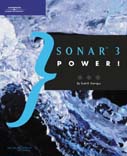SONAR 3 Power! tips from Scott Garrigus—part two
Last updated on 3/28/2016 SONAR 3 Power! |
In the SONAR Power! series by Scott Garrigus, you will find helpful tips on an assortment of topics. We have collected a small sampling of tips from SONAR 3 Power! chapters 5-8 that deal with some of the recording, playback and editing features in SONAR. Links to the latest versions of the SONAR Power! series and other SONAR related books can be found here. |
SONAR 3 Power! tips from Scott Garrigus—part two
Now time shortcuts
If you want to set the Now time quickly to a particular measure or beat, you don't have to enter all the numerical values. For example, to set the Now time to measure two, type 2. That's it. Or to set the Now time to measure five, beat three, type 5:3 or 5 space bar 3. To specify ticks, you must enter something for all the values.
Real-time markers
Usually, you add markers to a project while no real-time activity is going on, but you can also add them while a project is playing. Simply press the F11 key on your computer keyboard, and SONAR will create a marker at the current Now time. The new marker will be assigned a temporary name automatically; you can change this name later.
Monitor on all tracks
You can easily activate or deactivate input monitoring on all audio tracks at once using the Playback State toolbar. Make the toolbar visible by choosing View>Toolbars>Playback State. Then use the Input Echo button on the toolbar to adjust input monitoring.
The decibel
Decibel is a very complicated term to describe. The most basic explanation would be that a decibel is a unit of measurement used to determine the loudness of sound. In SONAR, the audio meters can range from -90 dB (soft) to 0 dB (loud). To change the display range of a meter, right-click on it and choose a new setting from the drop-down menu. For a more detailed explanation, see the following topic in the SONAR Help file: Editing Audio>Digital Audio Fundamentals>The Decibel Scale.
Quick clip copy
You can copy a clip quickly by holding down the Ctrl key on your computer keyboard and clicking and dragging the clip to a new location. A copy of the clip will be made and placed at the new location.
Tap the spacebar to adjust tempo
Instead of using your mouse to click on the Click Here to Tap Tempo button, you might find it easier (and more accurate) to use the spacebar on your computer keyboard. Click on the button with your mouse once to highlight it, and then use your space bar to tap out the tempo value.
Set the default crossfade
If you use a particular type of crossfade most often, you can set the default crossfade type. Just click on the small down arrow next to the Enable/Disable Automatic Crossfades button in the Track view toolbar to reveal a menu, which will let you choose the default crossfade type. This is also how you define he default fade-in and fade-out types.
Read part one of this series.
Read part three of this series.